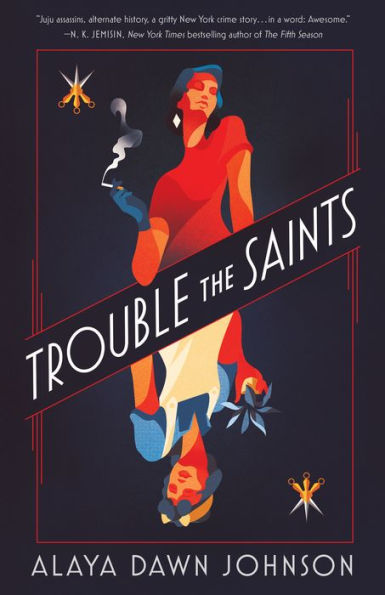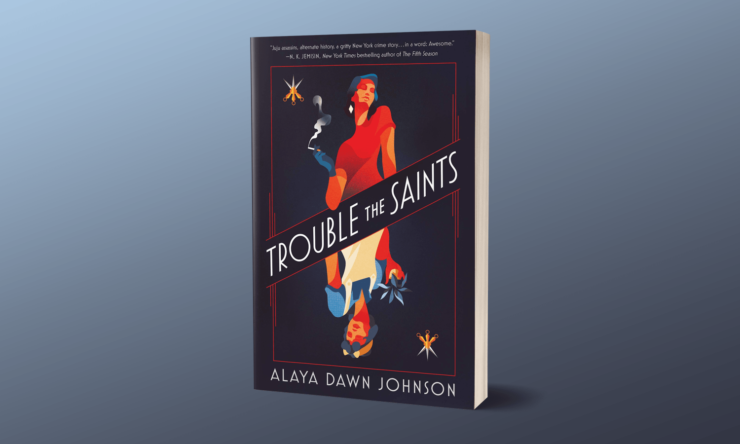Phyllis is good at her job—she’s got a knack for it, traceable to the day her powers, her “saints’ hands”, were revealed to her in a dream. That Phyllis’ job just happens to be killing people on behalf of Manhattan’s cruelest mob boss is beside the point. She kills for justice, after all, and only accepts hits on people that deserve it. Her righteousness and skill will only take her so far, however—they will not win back Dev, the man she loves, nor will they piece back together a world fractured by centuries of racism and hatred. What good then, are Phyllis’ bloodstained hands? What good can she possibly make of them?
Set in an alternate 1940s New York, Alaya Dawn Johnson’s Trouble the Saints interweaves history and unreality, the atmosphere of noir and the magic of fantasy, to form a moving, literary love story. It’s anything but a traditional love story, though. The love in its pages is romantic, familial, platonic, and generational—it is beautiful and it is painful in the way only beautiful things can be. And it is troubled at every turn by the consequences of racism: grief and trauma, fear and twisted desire, survival and community. The love in Trouble the Saints is bound up in a world and in a history that does everything it can to suppress it.
I should say first that I am not Black and can only bring my own perspective to my coverage of this novel. I am therefore not going to attempt to speak to the emotional realities of racial trauma, passing, or intracommunity conflict as portrayed in the book—they’re outside of my personal experience and I recommend you seek out reviews by BIPOC for better insight on those topics! Instead this review will focus on the novel’s themes, and the way that Johnson’s graceful structure and character-building lend themselves to those themes.
Buy the Book


Trouble the Saints
Trouble the Saints is told in three parts and by three characters: the just and calculating Phyllis—passing for white and aware at every moment that her survival hinges on it; the kind and steady Dev—a police spy made sick with moral ambiguity; and the sweet and glamorous Tamara—a dancer kept innocent by the violence of others. Don’t let the novel’s three parts fool you into thinking it follows a three-act narrative arc, however: the novel’s first part resolves what readers will anticipate is the crux of the story—Phyllis’ relationship not only with her mob boss but with Dev. The rest is all consequence and fallout, echoing with the reverberations of trauma—personal, generational, and intracommunity alike. With traumas revealed obliquely instead of as climactic revelations, this story structure—and the story in itself—shifts traditional plot arcs while shedding light on the non-linearity of healing.
Trauma, though, is less at the heart of the novel than love. Phyllis and Dev are very much a “second chance” romance—and their desire and chemistry are palpable both before and after their reunion. Johnson writes sex and longing without ever substituting one for the other, with scenes as steamy as they are fraught with emotion. Deep friendships, familial relationships, and even acquaintanceships are described with no less nuance and care: Tamara describes her love for Phyllis and Dev as “a blood love, a bone love, and it ricocheted off of her other loves at unexpected angles.” Dev tends to his mother’s roses. Phyllis loves her young nephew despite his religious judgement of her gifts. And each of the three main characters struggle with the ethics of providing care and support for others, at risk of safety and reputation. At the center of these relationships is the classic “us” versus “I” conflict—from Phyllis’ willingness to give up her past life of brutality for Dev, to the many instances of complicity in racial violence in the name of security.
The intensity of Johnson’s portrayal of love and sacrifice make the novel’s perspective on racism all the more effective. Hatred is not portrayed here as an easy, static thing, nor is it presented as desire’s opposite. Instead we see racism at its most violent and its most banal, as something embodied and something that can morph white desire for the Black body into fear and disgust. We see communities turned against one another in a fight for survival. We see the insidiousness of internalized self-hate, the literal magic passed down by ancestors mutated into something ugly and self-destructive. It would be easy therefore to say that Johnson writes hate as well as she writes love, but I think the poignancy of the novel is in the complexity of their interplay. After all, we see too the pain present in the very acts of love that create joy and goodness within the novel—the weight of expectation, the unknowability of the other, the moral judgement at the center of justice. Love, in Johnson’s world, is not tempered by racial trauma, but transformed by it. But love too, is transformational—and that is ultimately more powerful.
This review and analysis do more service to Johnson’s themes and literary project than they do to her prose or her story. In the case of the latter: the fewer spoilers, the better; it’s a crime story after all, for all that I’ve talked about love and hate. In the case of the former: the prose in this novel will pull you in even when the story moves slowly. And it does move slowly, missing traditional story beats in favor of a narrative that unravels with the logic and fluidity of a poem. It’s worth every turn of phrase.
Trouble the Saints is just plain gorgeous. It is gritty and violent and achingly real, but stitched through with fantasy. It is bittersweet and affective, but subtle and sneaking in its emotionality. But above all: how nice to be drawn into a story so bursting at the seams with love in all its beauty and terror.
Trouble the Saints is available from Tor Books.
Read an excerpt here.
Em Nordling reads and writes in Louisville, KY.










